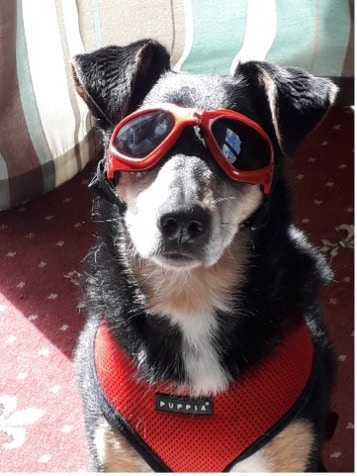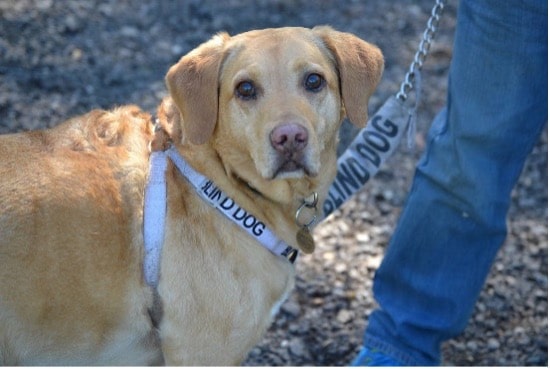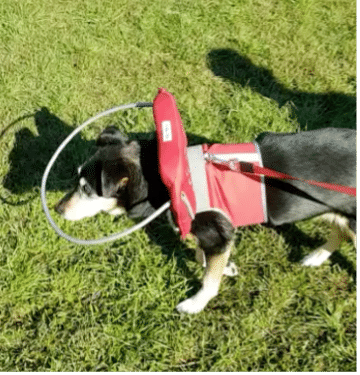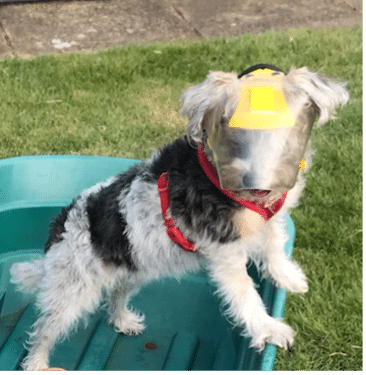At DWR Veterinary Specialists, our Ophthalmologists routinely accept referrals of pets from vets, who have lost their vision.
In many cases, the pet suffers from a disease for which there is no cure or straightforward treatment and they become visually impaired or irreversibly blind.
The following information will give you more details on the causes of blindness. We also have a page dedicated to some of our brave blind patients.
Causes of blindness
There are many diseases that cause blindness in dogs and cats; some of which may be treatable, such as cataract that you can read more about here, and others such as many retinal diseases, which are untreatable. Some diseases even require the removal of one or both eyes (enucleation) due to the pain it causes the pet, such as end stage glaucoma (high pressure in the eye).
Some of these diseases occur with rapid onset, like Sudden Acquired Retinal Degeneration Syndrome (SARDS), glaucoma or optic neuritis, whereas others cause a slow and gradual loss of vision, as in Progressive Retinal Atrophy (PRA).
- Cataracts are opacities (cloudy areas) of the part of the eye called the lens. If the cataract becomes large enough then it will cause visual impairment as the animal is unable to see through it.
- Uveitis is inflammation of the middle layer of the eye. It can cause eye pain and interference with vision.
- Glaucoma is a neurodegenerative disease that can affect one or both eyes and occurs when there is increased pressure inside the eye that damages the retina and optic nerve, resulting in blindness.
- Sudden Acquired Retinal Degeneration Syndrome (SARDS) leads to sudden and irreversible blindness. The disease is incurable and the cause is unknown.
- Progressive Retinal Atrophy (PRA) is a group of inherited diseases affecting many breeds of dogs and cats, leading to progressive incurable degeneration of the retina. Initially, it shows as partial vision loss (typically in dimly lit surroundings) and later progresses to total irreversible blindness. In addition, as the retina degenerates, it releases substances that can cause cataract formation.
- Retinal detachment describes a situation when the thin layer of tissue essential for vision (the retina) at the back of the eye pulls away from the layer of blood vessels that provides it with oxygen and nutrients. It can affect dogs and cats and leads to partial or total blindness.
- Optic neuritis is inflammation of the optic nerve of one or both eyes. The optic nerve connects the eye to the brain and inflammation results in blindness.
Living with a blind pet
How your pet will react and adapt to blindness will depend on several factors including the character and age of your pet. Plus, how sudden the blindness came on and its cause.
In our experience, dogs that slowly develop blindness and/or develop blindness very early on in life, tend to cope extremely well. Whereas older and larger breeds, and those dogs that experience a rapid onset of blindness tend to take longer to adapt and may require more support from you.
Your blind pet needs time to develop new skills and may rely on you more than they previously did until they build their confidence up again.
The following information will help you with how to live with a blind pet and provide some practical tips and further references. We also have a page dedicated to some of our brave blind patients.
Practical Tips:
- Positive reinforcement and motivation for your pet: give them as much positive feedback as possible, when previously easy things such as jumping in and out the car or walking up/down steps are achieved again.
- Keep the light on inside the house if some remaining retinal function is present. In slowly progressing diseases such as PRA, bright light can be helpful to differentiate light and dark objects.
- Teach new voice commands such as “stop”, “wait”, “careful”, “steps” etc. This will help to prevent your dog misjudging objects that may result in serious accidents and negative experiences that could affect their confidence.
- Clicker training can be very helpful in training a blind dog, especially as it is a consistent training method, which is even more important with blind dogs than sighted ones.
- Use training objects with different textures, smells and noises (For example: put bells on the doors, use a dog whistle, place a dab of a scent at the top or base of staircases). This will help your dog associate specific smells/sounds with certain objects. If your cat enjoys cat nip, you can use this scent to create paths leading to your cat’s favourite spots in the house.
- Stimulate their other senses such as smell, touch and hearing on a regular and consistent basis. For example, play games using toys with bells or rattles every evening at a certain time, or hide treats around the house.
- Keep the furniture, food, litter trays and water bowls in the same position as much as possible. This will help your dog and cat learn which routes to take through the house.
- Similarly, try to keep the floor tidy and free from hazards – it is disappointing for your dog running into/over unexpected objects and may negatively affect their confidence.
- You may also find it useful to use more than one litter tray for your cat, especially if they just lost their vision.
- Keep your blind cat indoors unless closely supervised.
- Choose a walking route and stick to it – although this may seem boring to you, your dog will find this less stressful, and it will give them more confidence.
- Use a harness instead of a collar – this will provide more support and again, give your dog more confidence.
- Do not let your dog off the lead in an unknown environment; this can be very confusing and dangerous for them.
- Your dog’s behaviour towards other dogs may change; let the other dog owners know that your pet is blind to avoid unnecessary accidents, for example: use a labelled harness or lead (see the photo below.)
- A fully sighted companion dog for your blind dog can be helpful, although this may depend upon the temperament of your dog. The sighted companion may become a guide, boosting their confidence and making your blind dog happy. If you consider introducing a new dog to the house, then also consider your dog’s behaviour to make sure she/he will accept another pet at home.
- Consider some of the products below to keep them safe:
- Stair gate
- ‘Halo’ for dogs; a wire suspended around a head and neck which acts like a bumper
- Doggie goggles (often called Doggles) or visors to help protect their eyes, especially in new surroundings
- BlindSight® is a new product for dogs which uses echolocation to help them navigate (A recent study suggests that this device might be more suitable for medium and large breed dogs. (Bedard K.M et al.2020)
- There are other products as well such as hoops and harnesses to protect your dog and make others aware they are blind. Here are some examples of previous patients of ours.
Useful references
If you search the internet you will find many websites with products for blind animals such as eye protections as well as advice from charities and reputable organisations. Here are also some useful books and links.
Caroline D. Levin. Living With Blind Dogs: A Resource Book and Training Guide for the Owners of Blind and Low-Vision Dogs, Second Edition. 2003.
Symons K. Blind devotion. Enhancing the lives of blind and visually impaired dogs. 2011.
Caring for a Blind Cat by Natasha Mitchell. 2008.
https://icatcare.org/advice/progressive-retinal-atrophy/
Here are some examples of products with previous patients of ours, you can read their stories here.





